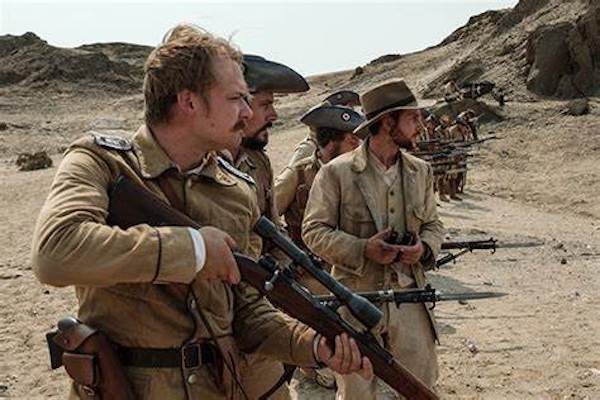Film Review: Mass Murder, the Prequel — “Measures of Men” Exposes Germany’s Bloody Colonial Past
By David D’Arcy
The film’s depictions of race-based massacres are sure to make Germans uncomfortable — as preludes to the Shoah.
Measures of Men, directed by Lars Kraume.

A scene from Measures of Men.
In 1904, some 120-150 German soldiers in German Southwest Africa, now called Namibia, were attacked and killed by Africans angry at the theft of their land and livelihood. In response, German authorities, who claimed German Southwest Africa for their empire, sent troops to punish the rebels.
Four years later, two African peoples — the Herero and the Nama (also called Hottentots) — had lost some 80,000 men, women, and children. Some estimates put the toll over 100,000. Many fled into the desert. Concentration camps were set up to punish those who weren’t killed outright. Survivors were put to work on German farms and building sites, and in the newly exploited diamond mines that relied on African labor.
The British seized control of German Southwest Africa in 1915 — during World War I — but the territory retains a German character, with German hymns in Lutheran churches, a German newspaper, and streets named after Bismarck.
The bloody campaign that began in 1904 is remembered by some, more than a century later, as the Kaiser’s Holocaust. No surprise. The army commander there at the time issued an order, later rescinded, to shoot all Hereros. It wasn’t the only brutal German campaign against the local population. The Khoi or San, known as Bushmen, were considered “untamable” and slaughtered in great numbers.
The war in Namibia and the role German ethnologists played in studying populations crushed by German troops is the focus of the film Measures of Men (Der Vermessene Mensch in German), which opened in theaters in Germany last weekend. Directed by Lars Kraume, the historical drama premiered at the Berlin International Film Festival on February 23.
This is a bloody period costume melodrama, with troops slaughtering a native population and leaving thousands to starve. Eugenic science — the measurement in the title — forms a parallel plot here. The massacres provide bodies so ethnologists could study the bodies (via “craniology”) of a defeated race that had already been judged to be inferior.
Despite a style right out of commercial cinema, Measures of Men probably won’t be a popular hit. The story’s depictions of race-based massacres are still sure to make Germans uncomfortable — as preludes to the Shoah. It dramatizes the evidence that the German policy of systematic mass murder didn’t begin with Hitler. And this grand Hollywood-style war drama lacks anything like an Oskar Schindler dedicated to saving the doomed victims in his care.
Many Germans, especially younger Germans, know nothing about the murderous wars in Southwest Africa. Most of that younger generation doesn’t watch movies in theaters anymore, but media coverage could make this film’s revelations hard to ignore.
The tale begins in Germany, with a delegation of Black Africans at a research institute. The Africans, from the top of their school classes, speak German. They expected their visit to be educational. It is, but not as planned. Academics practicing the new discipline of ethnology measure their heads and noses and other body parts, rating their intelligence based on anatomy. The visiting Africans are shocked: young Kezia Kunouje Kambazembi (Girley Charlene Jazama) conveys the collective alarm to a well-meaning ethnologist in training, Alexander Hoffmann (Leonard Scheicher). It doesn’t end there.
In Southwest Africa, Hoffmann, now in tow for practical ethnology training, observes German troops punishing locals for their attacks on soldiers. Those who won’t relocate their homes are shot when they protest. Prisoners languish in squalid concentration camps. Some are sent to Shark Island, off the coast of the port of Luderitz, where they prepare bodies and heads for shipment to Germany for academic study. Hoffmann visits the jail and finds Kezia, now a prisoner, scraping the hair off skulls.
Germany set the bar high for atrocities in the 20th century, but the film’s portrait of genocide is an organized campaign of mass murder — crude, but efficient enough for the bodies to pile up.
In Namibia’s rugged hills and endless sandy deserts, the comparisons with Hollywood westerns are inevitable. There is more than a visual resemblance. Besides killings, the German dominion over Southwest Africa involved theft of sacred objects and forced migration, as in the United States.
And as it did in other German colonies. In northeast New Guinea (the Bismarck Archipelago), which Germany seized around that time, there were similar patterns of killings and cultural pillaging. German social scientists classified the local residents, who lacked a written language or history, as inferior “nature people,” destined for extinction. Troops posted to protect traders accelerated that process, burning settlements as they swarmed through. Some of the troops, and the physicians and clergy who accompanied them, kept detailed accounts, which the historian Götz Aly cites in The Magnificent Boat: The Colonial Theft of a South Seas Cultural Treasure, his study of a 50-foot outrigger canoe, seized in the 1890s and shipped to Germany along with human remains. The vessel, the last of its kind to survive from that defeated culture, is now on view at the massive Humboldt Forum devoted to non-Western cultures in the center of Berlin. Aly’s book, published in German two years ago, is due out from Harvard University Press this spring.

A scene from Measures of Men.
Namibia today is still shrouded in what one scholar called “the mists of amnesia.” Even now, some see the German settlers of Southwest Africa as victims of war, occupied by British troops in 1915. Long subject to South Africa’s apartheid laws, a free Namibia after independence rejected the establishment of Truth and Reconciliation Commissions. Over time, the murderous abuses of Africans by the Germans have become a matter of distant history, although Uwe Timm’s 1978 novel Morenga, set during the Herero War, became a series for German television. (An English translation of Morenga was published by New Directions in 2005).
At the Berlin premiere of Measures of Men, a self-selected audience of Germans and those descended from Africans once ruled by Germans criticized delays in addressing a genocide that took place over a century ago. The film might put those horrors — and Germany’s responsibility for them — back in political focus, as Germany now backpedals from an agreement to pay some $1.2 billion in reparations to the Herero and Nama people. The excuse? Paying that agreed amount (Germany won’t call it reparations) would have made it easier for Greece and Italy to demand compensation for crimes committed during the Nazi era.
David D’Arcy lives in New York. For years, he was a programmer for the Haifa International Film Festival in Israel. He writes about art for many publications, including The Art Newspaper. He produced and co-wrote the documentary Portrait of Wally (2012), about the fight over a Nazi-looted painting found at the Museum of Modern Art in Manhattan.

There is also a play about this genocide by Jackie Sibblies Drury “We Are Proud to Present a Presentation About the Herero of Namibia, Formerly Known as Southwest Africa, From the German Sudwestafrika, Between the Years 1884–1915”. Quite powerful even without the visual gore .